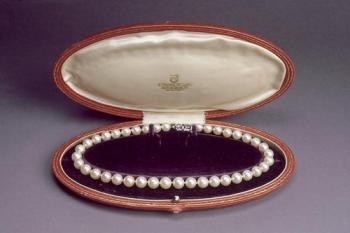|
Worldwide Traveling Exhibition: Pearls A Natural History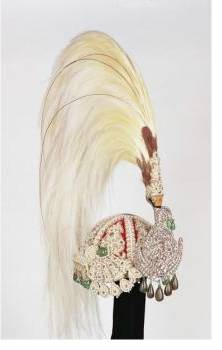
Enjoy my visit to the "Pearls a Natural History" exhibit in Tokyo, Japan.
Photos on this page courtesy of Toronto Fashion Monitor. Muscatine Pearl Button display adds a local touch to "Pearls: A Natural History" exhibit which is currently traveling the world. Last fall (2005) two of my sons, Sam, Matt and myself ended up in Tokyo due to lack of planning on my part which caused us to miss the boat from Shanghai to Osaka. I was counting too heavily on a knowledgeable taxi cab driver and didn't allow enough margin of time for errors. Our only return option to Japan in order to catch our flight was to fly into Tokyo. As usually seems to happen, our disappointment turned into blessings: First, we got to visit Tokyo; Second, it enabled me to visit and write about several Mikimoto pearl stores for this website about pearls; Third, we discovered the "Pearls A Natural History" was in Ueno Park, not far from our Japanese style hostel. After a morning hustling around Tokyo visiting the main Mikimoto store in Ginza and several other Mikimoto store locations, I hurried back to the hostel to meet Sam and Matt so we could go together to Ueno Park. The crowded Tokyo subways are easy to navigate, but once at Ueno Park, we had no clue where the science museum was and a police officer kindly gave us a map. For the past three years I've been buying, selling, learning about, researching, and writing about pearls...so you know I was thrilled to "run into" this exhibit which contains over 600 pearl objects on loan from museums and private collections.
Typically, the exhibit has seven sections. First Section of "Pearls A Natural History": IntroductionThe introduction area explains pearl diving and displays pearl objects as they relate historically with tradition, royalty, glamour and religion, such as a pearl encrusted Russian icon from the 19th century.
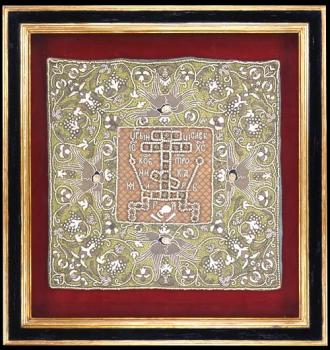 Also on display is this classic cultured Mikimoto pearl necklace given to Marilyn Monroe by Joe DiMaggio during their 1954 honeymoon in Japan.
Before diamonds were even discovered pearls were prominent and the Persian Gulf, the Red Sea and the Gulf of Mannar were the pearl market hubs. Next the center shifted to India during the Renaissance when masses of pearls were shipped to Europe for royalty. Christopher Columbus opened up the vast availability of pearls off the Venezuelan and Panama coasts in the Americas which were near depletion only 150 years later. This restored the Indian Ocean once again as the hub for pearl harvests. Since the 1920's and the development of the cultured pearl, Japan came to the forefront in pearl production and now China also has a vast market for pearls. Of course, all during this time natural pearls were being found all over the world, sold, sometimes by the handfuls, made into jewelry and enjoyed by varied groups of people. Second Section of "Pearls A Natural History": What are Pearls?So just what gives a pearl its shape, color and appeal? Here the biology, micro-structure and chemistry is illustrated with a magnification 50,000 times of the layers of a pearl. Just like people, no two pearls are alike and a video presentation, interactive displays and historical and modern pearl objects prove this fact. Visitors may view a large selection of multicolored pearls and lustrous fossil pearls. But just exactly how is a pearl formed? Do the ancient myths have any bearing on reality? Were the Romans correct when they assumed pearls were frozen tears of gods? How about the Greeks idea of pearls forming when lightening strikes at sea? Even scholars until the 7th century thought that pearls were solidified dewdrops captured by clams. Even today, people often think pearls are formed from a grain of sand. This section in the "Pearls A Natural History" exhibit dispels these myths and explains that a pearl, primarily composed of calcium carbonate are created when a foreign object enters the clam and becomes lodged between the shell and inner lining or mantle. This invader could also pick up a piece of the mantle tissue as it passes deeper inside the shell. It's this mantle tissue that secretes nacre around the irritant, which becomes the nucleus, in concentric layers. The shape of pearls, both natural and cultured, depends upon the shape of its nucleus. Centuries ago Chinese would implant metal Buddhas which when covered with nacre became Buddha blister pearls. Fascinating facts demonstrated here with a large display covering a wall of various species of mollusks and the pearls they produced. Virtually any "shell animal" can produce pearls...even sand snails. Amazing! Not that every type of pearl has value, but this was of great interest to me.
Third Section of "Pearls A Natural History": Central GalleryHere one can view a replica of the Pearl of Allah, a natural pearl weighing over 14 pounds and the size of a man's head. This multimillion dollar pearl rested inside its huge mother clam. (I've often wondered what this pearl's "mother" looked like.) A lovely pearl and gem brooch of Queen Victoria's, a gift from Prince Albert for their 3rd wedding anniversary in 1843, solidifies the fact of a long standing alliance between pearls and royalty. 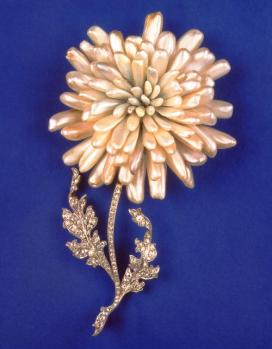
Pearls of the Americas from the Mississippi River are showcased in this creative chrysanthemum brooch (1904) made of gold, platinum and diamonds by the Tiffany & Company. It's very likely that these pearls were found locally in Muscatine, Iowa during the button industry's heyday when so many pearls were found that buyers bought them by the pound from clammers. Also in the central gallery of "Pearls A Natural History" is a pearl and shell studded tree illustrating the relationships among pearl-producing organisms. Fourth Section of "Pearls A Natural History": Marine PearlsHere is an unusual video clip of a Queen Conch leaping deep in the Caribbean waters along with conch pearls in a variety of colors. La Paz pearl objects such as a 3rd century carved La Paz pendant form Ecuador and an 1875 spider brooch of black La Paz pearl are displayed next to La Paz oysters. This festoon necklace of large, high-quality, rare, natural marine pearls was designed by Jacques Cartier in Paris in 1911. 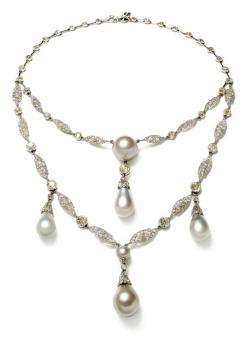
Fifth Section of "Pearls A Natural History": Freshwater PearlsImagine my surprise as I turned to corner to enter this section to see an over-sized photo of the familiar Beopple Pearl Girl advertisement from Muscatine and a display area devoted to Muscatine, Iowa, Former Pearl Button Capital of the World. Here I was in Tokyo, and learning about my home town. Along with a button cutting machine, there were large photos of John Beopple cutting button blanks and workroom photos. Galvanized buckets were filled with button blanks and cut shells with several buttons on cards on the walls. On the shelf above it all were a pair of button covered boots. 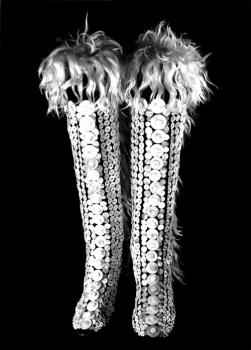
These reminded me more of the London Pearlies than of Muscatine, but were included here. American mussels still play an important roll in pearl production as the nuclei for many cultured pearls being grown today and a video explains this. I was very happy to see several pearls, on loan from the Latendresse family collection from Tennessee, including a graduated freshwater pearl necklace of natural pearls collected by John Latendresse.
Other freshwater treasures were jewelry made with numerous tiny natural pearls once belonging to Mary Todd Lincoln and a shell from New Jersey, which wasn't large at all, in which was inscribed: "This is the shell that a $1,000 pearl grew in." Its small size amazed me. This may be the famous Queen pearl found in Paterson, New Jersey in 1857 by carpenter Jacob Quackenbush. 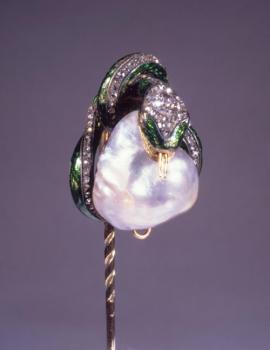
Sixth Section of "Pearls A Natural History": Gathering and Culturing PearlsPearl diving....ahhhh, now just how safe is this pastime or occupation? This section covers the topic thoroughly with various items displayed. Pearl culturing from 1600 years ago when the Chinese managed to manipulate mussels to cover metal Buddhas with pearl nacre to 1740 when Carl Von Linne, a Swedish naturalist cultured a spherical pearl, to just before the turn of the 20th century when Mikimoto's team fine-tuned the culturing process can be understood by the exhibit visitor.
Seventh Section of "Pearls A Natural History": Pearls in Human HistoryYes, it's humans that give pearls significance...and this section looks into the how the Greek and Roman eras related to pearls, explains how the 16th and 17th centuries were the "Great Age of Pearls," and points out 20th century designers who emphasized pearls. A most impressive array of pearl articles are included in this section...even Barbara Bush's fake pearls with a letter explaining that, "Yes, they are imitation and that now her secret was 'out of the bag.'" A special treat at the Tokyo showing was the Mikimoto Liberty Bell. This magnificent bell is encrusted with pearls with the crack being different colored pearls. Its home normally is in the Mikimoto Pearl Island Museum.
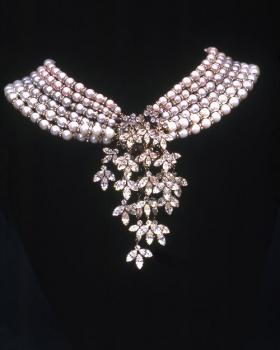
I highly recommend this exhibit...if you get a chance to see it, by all means....GO! "Pearls A Natural History" exhibit is in Sydney, Australia until August 6, 2006, but don't worry, this exhibit will go to several other world-wide destinations...hopefully to one near you. More information may be obtained here at the American Museum of Natural History website.
|



